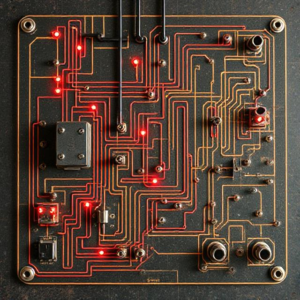Types of Circuits
In the world of electrical engineering, circuits play a critical role in allowing the flow of electric current to power devices and systems. Electrical circuits can be categorized in different ways based on their configuration and the behavior of current flow. The basic types of electrical circuits include Series Circuits, Parallel Circuits, and Combination Circuits. Each of these types has its own unique characteristics and applications. Let’s explore each type in detail.

1. Series Circuits
In a series circuit, all components are connected end-to-end, creating a single path for the current to flow. The current flows through each component in turn, and the same current passes through all of them. If one component fails or is disconnected, the entire circuit is broken, and no current can flow.
Key Features of Series Circuits:
- Current: The current is the same throughout the circuit because there is only one path for the current to flow.
- Voltage: The total voltage across the circuit is the sum of the individual voltage drops across each component. According to Kirchhoff’s Voltage Law (KVL), the sum of the voltages across all components in a series circuit must equal the total applied voltage.
- Resistance: The total resistance in a series circuit is simply the sum of the individual resistances of each component.
- Advantages:
- Simple and easy to construct.
- Useful in applications where the operation of each component is dependent on the others, such as Christmas lights where the lights turn off if one bulb blows.
- Disadvantages:
- If one component fails (like a bulb), the entire circuit is broken, causing all components to stop working.
- Not ideal for applications where reliability is critical.
Applications:
Series circuits are often used in applications where the components need to operate in a sequential manner, such as in string lights or some battery-powered devices.
2. Parallel Circuits
In a parallel circuit, the components are connected in multiple paths, meaning the current can flow through more than one path simultaneously. Each component has its own direct connection to the power source. This setup ensures that if one component fails, the rest of the circuit continues to function.
Key Features of Parallel Circuits:
- Current: The total current in a parallel circuit is the sum of the currents flowing through each branch. According to Kirchhoff’s Current Law (KCL), the total current entering a junction equals the total current leaving the junction.
- Voltage: The voltage across all components in a parallel circuit is the same. Each component experiences the same potential difference as the power source.
- Resistance: The total resistance in a parallel circuit is not the sum of individual resistances; instead, it is found using the reciprocal formula:
- Advantages:
- If one component fails, the rest of the components remain operational. This makes the parallel circuit more reliable than a series circuit.
- It is easier to control individual components without affecting the others.
- Disadvantages:
- More complex to design and install.
- Requires more wires and can lead to higher costs and increased power consumption.
Applications:
Parallel circuits are commonly used in home electrical systems. For instance, in household wiring, lights and appliances are connected in parallel so that if one light bulb blows, the others remain lit. Similarly, this setup is ideal for devices that require the same voltage but operate independently of one another.
3. Combination Circuits
A combination circuit is a hybrid configuration that contains both series and parallel components. These circuits are used when the application requires more complex electrical behavior, where certain components need to be in series, and others in parallel.
Key Features of Combination Circuits:
- Complexity: As the name suggests, combination circuits are a mix of both series and parallel connections, offering a more complex arrangement for controlling various components.
- Current and Voltage: The analysis of current and voltage in combination circuits involves breaking down the circuit into simpler series or parallel sections and then applying Kirchhoff’s Laws (both Current Law and Voltage Law) to solve for unknowns.
- Resistance: The total resistance is found by calculating the total resistance of the series components first, and then applying the parallel resistance formula to the resulting total.
Advantages:
- Offers flexibility in design.
- Can meet specific needs for both current and voltage behavior.
Disadvantages:
- More difficult to analyze and troubleshoot due to the combination of both series and parallel elements.
Applications:
Combination circuits are used in more advanced electronics, such as in power supplies, where different sections of the circuit may require different current or voltage configurations. They are also used in circuit boards and other sophisticated electrical systems.
Conclusion
Understanding the different types of circuits—series circuits, parallel circuits, and combination circuits—is essential for designing and analyzing electrical systems. Each type of circuit offers unique benefits and is suitable for different applications. Series circuits are simpler but less reliable, while parallel circuits offer more reliability and flexibility. Combination circuits are used when both types of connections are needed within the same system. Each type of circuit has its own set of characteristics, and the choice of which one to use depends on the requirements of the electrical system and the desired outcome.








